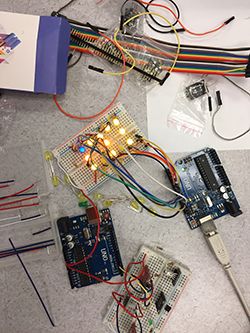In this section, Andrew Ringler shares practical tips for facilitating hands-on learning experiences in the workshop.
Think Strategically about Supplies

Participants programmed Arduinos to make LEDs blink. (Image by H. Sharon Lin, MIT OpenCourseWare.)
In preparing to facilitate hands-on learning, we first think about the kinds of supplies that will inspire and enable participants to independently engage with the target technology. For the this workshop, we purchase several Arduinos, and then hundreds of other types of components that are fun to explore with them. Some of the components are really easy to use and allow participants to dig into the technology (and have success) right away. The LEDs that we purchase, for example, are just simple lights. In about an hour, participants are able to use their Arduinos to make the LEDs blink.
We also have on hand more challenging components, such as accelerometers and distance sensors. If one of these challenging components seems interesting to participants, we encourage them to grab it and play around with it. We nudge them to look online, and to try to figure out how to use the component by themselves or with teammates. Very quickly, participants are exploring the course at different levels.
Having enough equipment such that every participant, or at least teams of participants, can explore independently like this is essential. It’s at that point that our our jobs, as instructors, become less about directing learning, and more about facilitating it—which is our ultimate goal.
Encourage Borrowing
In addition to providing participants with enough equipment to explore the Arduinos independently, it is also important to think ahead about facilitating a culture of openly sharing the materials. We encourage participants to borrow equipment as a way to fuel their interest and engagement with the technology. Many participants take components home and code overnight. We definitely lose a lot of equipment. This can be frustrating, but ultimately we feel okay about it, because it means students are engrossed in their work. We don’t require that they check out equipment or police them too much because we’re not buying a lot of expensive materials. Most of it gets returned, and we build up supplies over the years.
Select a Well-Documented Technology
Finally, another key aspect of facilitating hands-on learning is selecting a technology that is well documented and has a rich online educational presence. Arduinos are used in all sorts of educational settings, from elementary schools to universities to professional settings. There is a rich ecosystem of people using Arduinos, so the technology lends itself to self-learning. The abundance of Arduino tutorials makes self-paced hands-on learning in the workshop not only possible, but exciting.










